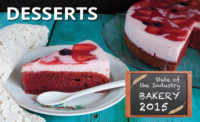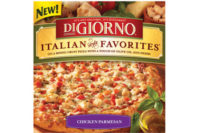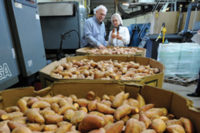Built in 1996, Eli’s Cheesecake Co.’s 62,000-sq.-ft. Cheesecake World bakery in Chicago is a busy place. The cheesecakes have become so popular that the plant uses more than 4 million lb. of cream cheese, 500,000 lb. of eggs, 250,000 lb. of butter, and 13,000 lb. of Madagascar Bourbon vanilla annually.
“You also have to be really good at what you do to make it today,” affirms president Marc Schulman. “We truly do go through that much product, so we just never stop. It’s a challenge, but in the baking business, we’ve seen numerous consolidations and buyouts. So we use our strength to make artisan specialty products. That’s our niche. It’s not anything that a large or global company can do.”
Swiss army knife operation
The energetic crew of 215 employees creates some 200 stock-keeping units (SKUs) of frozen desserts, such as mouth-watering Red Velvet, Pumpkin and Bavarian Apple Pie cheesecakes. “Yet every dessert has to be a masterpiece,” Schulman says. “My father used to say, ‘Take all you want, but eat all you take,’ which means we have to have balance. We don’t move too quickly on the production floor because that’s where you can have problems. We have a small-batch focus and maintain it. We have big eyes and a vision, but we have to control things.”
Arranged to flow in a giant circle, from incoming raw goods and bulk dry-goods storage to finished product shipment, the plant runs two eight-hour shifts each day for everything except baking crusts and sanitation, which both take place in a third eight-hour shift. “We’re a 24-hour-a-day bakery and usually work five days a week,” explains Jeff Anderson, vice president of purchasing and operations. “Certain times of the year, we’ll work six days a week and for some projects, we’ll work seven days.”
Highly organized plant personnel can set up and take down a cake assembly/packaging station in about 30 minutes. “This place is busy all day,” says Anderson. “The production operation is pretty much like a Swiss army knife [in terms of versatility]. On any given day, we run anywhere from 12 to 20 SKUs, so we have to be pretty flexible. But we’ve gotten away from being too speedy, because speed kills. We want to do things right the first time, so we try not to rush. We have eight production lines going at any given time, and the lines are changed over constantly, all day long.”
On the day of SF&WB’s visit, one of the lines was running a new, 3-in., single-serve, round raspberry swirl cheesecake. First, we headed into the temperature-controlled mixing room (set at about 60 to 65 deg. F.), which is equipped with five, 500-lb. planetary mixers and baker’s racks nearly as far as the eye could see, filled with all-butter cookie crusts baked the previous night. “The crust bakers arrive here at 6 p.m. and will make roughly 15,000-17,000 crusts per night, sheet them on our sheeting line and stamp out the rounds and bake them,” Anderson explains.
A mixing bowl filled with a batter of cream cheese, sugar, salt, eggs, sour cream and other ingredients is lifted up by a crane system and tilted as a large spatula with a plastic paddle is used to pour the batter into the pans containing the multiple mini crusts. A recently installed depositor used for this single-serve application shakes the batter to deposit it evenly in the pans and remove bubbles. “We just started to working with this on rounds, and we initially started using it for sheet trays,” Anderson points out. “It’s electronic and can work with an amazing range of products, from meringue to pastes. It has as modular design so it can be upgraded in the future, and we can change the heads and run large and small cake rounds and even lay down a ganache strip.”
Swirling and baking
Line operators also unload empty pans from racks, while others spray the pans with oil. The pans of batter receive a raspberry topping deposited into the pans’ small cavities before a group of operators “hand” swirl the raspberry. Next, the pans convey toward the oven. Another line operator places a pan under the first pan filled with cheesecakes and sprays the “base” pan with water, to create a “bain-marie” for the heating process.
The pans next convey into the 70-ft.-long, four-zone tunnel oven. Up to 18,000 cheesecakes can travel along the conveyor and through the oven. The small cakes bake for 31 minutes at 400 deg F., but baking times and temperatures vary for the many desserts baked here. Meanwhile, pans of more baked crusts on racks are at the ready.
For short production runs and certain types of cakes, the company uses a bank of seven rack ovens for baking. “We run plain cheesecake in the tunnel oven but small batches of products are baked in the rack ovens because of their profiles,” Anderson explains. “They bake better in rack ovens.”
The production lines feature touchscreen programmable controls that are easy to learn to use, Anderson says. “We save recipes and programs, and some of our PLCs even have a Spanish component so we can toggle back and forth between languages,” he adds.
After baking, the cheesecakes take a leisurely journey through a spiral cooling tower and back down again, spending 20 to 30 minutes in the tower before they’re moved into the freezer and later to a packaging room for hand-packing. The densely coiled spiral cooler slowly can cool more than 2,000 cheesecakes at a time.
The artisan way
With few exceptions, fillings such as those with fruit components, lime curd and raspberry/white chocolate, and toppings such as brown streusel, are made in-house from scratch. Eli’s also has five specialty pastry chefs who make the toppings and fruit components. They also develop new products in a research and development lab, selecting only “the finest ingredients,” Anderson states.
“We bring in the cream, the chocolate, the Individually Quick Frozen (IQF) fresh fruit, and we don’t use a lot of flavorings but those that we do use are all-natural,” he says. “Most everything here is made from scratch, which creates a lot of challenges. You have to have a good process and it requires a lot of training to make all of these things, but we feel we get higher quality and have more control this way. If we want to change something or make a small adjustment, we can do it pretty easily.”
That’s another reason why it’s key to be all under one roof, says Schulman. “The entire company is in one place,” he explains. “That way, we don’t miss anything in terms of communication. We’re always evaluating and things are flexible enough to move quickly on customer requests.”
As the 3-in. cheesecake rounds travel in a single file down the conveyor belt, operators place them back on the pans and place the pans in racks. The racks are moved to the decorating/packaging room and they sit in a staging/cooling area. Many products are instead moved to a blast freezer where work in progress waits before it’s the right temperature to be decorated, cut and packed. “Our main freezer is in the back,” Anderson says. “We don’t ship much product from here. Instead, we freeze everything and ship it to third-party cold storage off-site, and it’s shipped to the marketplace from there. In the blast freezer, cakes freeze solid in eight to 10 hours.”
Custom decorating
Back in the main decorating/packaging room, any number of functions are being performed on equipment, including mobile depositors and conveyors, rotary slicers, cartoners and wrappers. (Anderson notes that packaging graphics on the retail cartons are frequently updated; some display a happy image of Eli Schulman on the front.)
The decorating process involves great teamwork and can take several steps. Roughly 30 trained pastry chefs and cake decorators hand-decorate most of Eli’s cheesecakes, assembly-line-style. There are four levels of decorators, with the most accomplished performing the most detailed tasks with piping bags. Decorating personnel use star-headed pastry bags and semi-automatic depositors to apply either mousse, drizzle or frosting on the top of the cakes. Other operators then finish off the cakes with special touches and spatulas.
“On average, we output 400 to 500 units in a production run,” Anderson says. “A really large run is anything more than 1,000 units. We usually have smaller batches or quantities.”
Again, the Swiss army knife concept comes into play. Everything is on wheels, there are drop cords for power and air, and every day is a bit different. “None of the equipment is bolted down,” says Anderson. “Typically, while we’re on one line decorating, another line is dismantled, the equipment is moved into our washdown room and something else is set up.”
The used equipment is first scraped down extensively to remove food waste, fats, oils and grease before it’s thoroughly cleaned according to regulations.
Meanwhile, over in packaging, personnel secure large, finished cheesecakes gently with round paperboard bases and fit them with paper collars before placing them in the semi-automatic cutters—all portable and adjustable for cake size. The cakes then receive paper inserts and are sent through a wrapper and shrink tunnel to secure them in clear film. They’re then cartoned, labeled, coded with an ink-jet system and sent through a metal detector. As the packaged cakes accumulate on a rotary table, operators load them into corrugated shipping cases.
The cases are semi-automatically tape-sealed, printed with production information, labeled and palletized. The raspberry swirl mini cakes are placed in a sealing machine that packs them in clear plastic single-serve thermoforms. The pallet loads are then moved to the freezer.
Food waste is recycled into animal feed, and materials such as paperboard, corrugated, plastics and aluminum are also recycled. Landfill hauls are very small, Anderson says.
Safety first
All of the procedures are documented by Quality Assurance auditors throughout the bakery. “Our QA auditors check for food-safety steps and the proper documentation, while the leads and line foremen inspect quality and other parameters,” Anderson adds. “We have two Hazard Analysis Critical Control Points (HACCP): One is our baking step, and the other our metal detection station on the packaging lines.
Planning for the future, Eli’s is implementing a food-safety-certification program through the Safe Quality Food (SQF) process, Schulman explains. “Our product quality has always been first-rate, but now, food-safety education and SQF training is vital.”
The company’s comprehensive SQF program for all associates is designed to enlighten the staff, Anderson says. Eli’s has brought in the American Institute of Baking International (AIB) as a training consultant. “We have different workshops all the time that focus on different aspects of food safety,” he continues. “They really know how to deliver the message and help us completely customize the workshop.
“The goal is to increase the staff’s awareness about the fact that what they do impacts food safety. Every time they’re on the production floor, touching equipment and working with product, for example, there’s a potential to impact food safety, negatively or positively. So we’re learning how to better monitor things and demonstrate the best way to do things properly and hygienically. After all, we’re only as strong as our weakest link.”
Already there are benefits to using SQF. “It’s forcing us to change our culture in good ways,” Anderson says. “Our staff will take on more ownership, and one of the best parts of the classes is having the insight from AIB.”
Planning to expand
Because there’s never a dull moment at Cheesecake World it seems, the company has a lot of things planned for the near future, such as expanding its production space. “Even though we’re doing very well with the operation as it is, we need more room to add another production line, and we’d like to add another tunnel oven,” Anderson points out. The property on which Cheesecake World resides has an extra 45,000 sq. ft. on the south and west sides that will allow for an addition.
“It’s a challenge to work during construction, but it will also be fun,” he says. Judging by all of the smiling faces on the busy decorating lines, fun and cheesecake go together, so he’s probably right. SF&WB
















